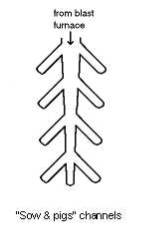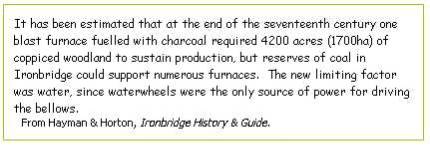 |
 |
Henry Cort Inventor - Creator of puddled iron - Father of iron trade |
 |
 |
| This page is part of a website based on the life and achievements of eighteenth-century inventor Henry Cort. The creator and owner of the site was Eric Alexander who passed away. The site is now hosted by Geneagraphie.com Please contact us with any comments or queries. |
- Homepage
- Life of Henry Cort
- Cort's processes in iron manufacture
- Cort's patents
- Refutation of allegations of conspiracies against Cort
- Adam Jellicoe's death
- Henry Cort's birth
- A navy agent's business
- Early life of John Becher
- Attwick & Burges families
- "Cortship" of second wife
- Thomas Morgan
- Henry Cort's hoops contract
- 1856 Accolade
- Generosity of friends 1789-94
- James Watson
- Illness of Cort's son
- Main sources of information
- Contemporary sources
- Navy sources
- Chancery files
- Publications about Cort
- Assessment of Cort's character
- Images of Henry Cort
Impeach-tranferred to 05
- Parliamentary inquiry 1811-2
- The furore of the 1850s
- Society of Arts
- Cort's first marriage
- Henry Cort's children
- Cort family pensions
- Henry Cort's Hertfordshire property
- 1791 signatories
- Guiana and the Cort-Gladstone connection
- Cort's twilight years
- Memorials to Henry Cort
- Smelting of iron
- Fining before Cort
- Shropshire & Staffordshire ironmasters
- Cumbrians: Wilkinson etc
- Early works at Merthyr Tydfil
- The Crowley business
- London ironmongers
- Scottish iron
- Cort's promotion efforts 1783-6
- Later Merthyr connections
- Puddling after Henry Cort
- Gosport in Cort's day
- Gosport administration
- Gosport worthies
- The Amherst-Porter network
- James Hackman, murderer
- Samuel Marshall
- Samuel Jellicoe's legacy
- Links with Titchfield
- Links with Fareham
- Fact, error and conjecture
- 18th century politics
- Law in the 18th century
- 18th century finance
- Religion and sexual mores
- Calendar change of 1752
- Shelburne, Parry and associates
- John Becher's family
- The Becher-Thackeray lineage
- Thomas Lyttelton: a fantastic narrative
- Eighteenth-century London
- Abolition and the Corts
- The Burges will tangle
- Navy connections
- Navy agent's business
- Cort's clients
- Ships' pursers
- History of Adam Jellicoe
- Dundas & Trotter
- Cort's navy office associates
- Toulmin & other agents
- Sandwich & Middleton
- The Arethusa
- John Becher's war
- Thomas Morgan's war
- The 1782 Jamaica convoy
- Sinking of the Royal George
- Visitors 2006-2009
- Developement of the site 2006-2009
- Daniel Guion and family
- Extremely bad academic work and extremely bad journalism
****************
|
|
Smelting of iron
Iron is one of the commonest elements in the earth's crust. It occurs in rocks, usually in combination with oxygen (Fe203) giving them a noticeable red (haematite) or yellow-brown (limonite) colour. The chemical process for removing the oxygen is called smelting.
For British iron workers, a freshly-smelted lump of iron is either a bloom or a pig. Whoever thought up these names deserves credit for imagination. They may not have been the first names used, but they were the ones that stuck. For centuries.
The bloom came to Britain first. It came via Europe from the Middle East, where iron technology is supposed to have started.
Wandering through an iron-producing area - Ashdown Forest or the Forest of Dean, perhaps - during the Iron Age, you might come across an early smelter (a "bloomery") in a clearing in the woods: probably just a hollow in the ground. You might see the workers load it with iron ore and charcoal, then light the mixture and fan it using bellows.
If you were a time-traveller from the twenty-first century, you might recognise the reaction going on, similar to the one in a modern blast furnace. You might know enough chemistry to write a balanced equation for it.
2Fe203 + 3C = 4Fe + 3CO2
You would know that charcoal is a form of carbon, which takes the oxygen out of the ore - "reduces" it, as the chemists say; that some of the charcoal acts as fuel, reacting with oxygen in the air to produce the heat you need to make the smelting reaction go; that impurities in the ore will form a layer of slag. All facts of which the early ironworkers are unaware: they just know that the process works.

You might expect the iron to come out liquid, as it does in the blast furnace. You would be wrong. The bloomery is not hot enough to melt the iron, which emerges as a spongy lump - a "bloom". The blacksmith will be close by, to hammer the bloom while it is still hot: hammering drives out most of the impurities and "consolidates" the metal into a small lump (called bar iron for many centuries, before chemists adapted the name wrought iron to describe it). The smith then takes it to his forge - probably in the same clearing - to work it.
You will have to travel some distance before you find the next bloomery. If they are too close together, they demand more wood for charcoal than the local forest can supply.
Come again a few centuries later: the main change you find is that the bloomery has become more sophisticated. Now it is a furnace about a metre high, and the bellows are less important. The bloom that comes out is bigger. Probably the clearing is bigger too, because a bigger bloomery demands that more trees are cut down for making charcoal.
Fast forward to the thirteenth century, where you may find an early blast furnace - larger than a bloomery, but not so large as a modern blast furnace. Look for a fast-running stream in the valley, a waterwheel driving the bellows that provides the blast.
 The mixture going into the furnace is much the same as in a bloomery, perhaps with the addition of limestone to help remove impurities. But now the iron comes out molten: with the extra heat in the furnace, it has absorbed carbon, lowering its melting point. It runs down a central channel and collects in side channels, where it solidifies. Someone with imagination thinks the cluster of channels resembles a sow suckling a litter of pigs: hence the name "pig iron".
The mixture going into the furnace is much the same as in a bloomery, perhaps with the addition of limestone to help remove impurities. But now the iron comes out molten: with the extra heat in the furnace, it has absorbed carbon, lowering its melting point. It runs down a central channel and collects in side channels, where it solidifies. Someone with imagination thinks the cluster of channels resembles a sow suckling a litter of pigs: hence the name "pig iron".
This type of iron, with its carbon impurity and lower melting point, is good for casting. But it is brittle and does not forge well. The blacksmith wants a purer form. He can still get it from a bloomery, but the size of the output from the blast furnace is so much greater that he would rather take the pigs and purify ("fine") them.
 As the demand for iron increases, the supply of charcoal to smelt it cannot keep up. A different material is needed to reduce the ore. Could coal be an alternative?
As the demand for iron increases, the supply of charcoal to smelt it cannot keep up. A different material is needed to reduce the ore. Could coal be an alternative?
Not quite, but coke is derived from coal and is (like charcoal) composed mostly of carbon. The impurities in coke (mostly silicon compounds) will, indeed, cause problems, as they contaminate the iron produced and make it difficult to fine. But for casting, the products of the coke-fuelled blast furnace are more than adequate: the problem of finding a substitute for charcoal in smelting has been solved.
Credit for this invention is usually given to Abraham Darby I in 1709, but recent research suggests that Shadrach Fox achieved the breakthrough a little earlier. However that may be, it is under the Darby family in their Shropshire works at Coalbrookdale that the process becomes commercially viable.
|
RELATED TOPICS Cort's promotion efforts 1783-6 Shropshire and Staffordshire ironmasters |
The pages on this site are copied from the original site of Eric Alexander (henrycort.net) with his allowance.
Eric passed away abt 2012
If you use/copy information from this site, please include a link to the page where you found the information.
